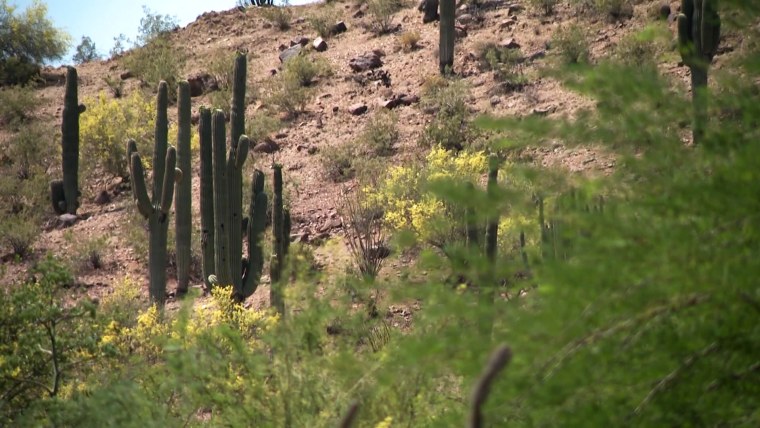PHOENIX — A historic heat wave that has gripped the U.S. Southwest throughout July, blasting residents and baking surfaces like brick, is beginning to abate with the late arrival of monsoon rains.
Forecasters expect that by Monday, people in metro Phoenix will begin to see high temperatures fall under 110 degrees Fahrenheit for the first time in a month.
But not on Saturday. The high temperature in the desert city with more than 1.6 million residents climbed past 110 degrees for the 30th straight day, the National Weather Service said. The previous record stretch of 110 or above was for 18 days in 1974.
There are increased chances on Sunday of cooling monsoon thunderstorms. Though wet weather can also bring damaging winds, blowing dust and the chance of flash flooding, the weather service warned. Sudden rains running off hard-baked surfaces can quickly fill normally dry washes.
Already this week, the overnight low at Phoenix Sky Harbor International Airport fell under 90 degrees for the first time in 16 days, finally giving residents some respite from the stifling heat once the sun goes down.
Temperatures also were expected to ease in Las Vegas, Albuquerque and even in Death Valley, California, where the weather service said the expected high of 122 degrees on Saturday is forecast to lower to 113 by Tuesday — along with a slight chance of rain.
Also in California, triple-digit heat was expected in parts of the San Joaquin Valley from Saturday through Monday, according to the National Weather Service in Hanford, California.
Gusty, late-afternoon winds were expected Saturday and Sunday in Santa Barbara County, posing an elevated risk of fire weather, the weather service in Los Angeles said. Hot, dry weather was also expected across nearby valleys, lower mountains and desert areas.
In Riverside County, a firefighter was injured as crews battled a wildfire that charred 3.2 square miles in the community of Aguanga, about 60 miles northeast of San Diego, authorities said Saturday. The so-called Bonny Fire was about 5% contained, authorities said.
A downward trend in Southwest heat started Wednesday night, when Phoenix saw its first major monsoon storm since the traditional June 15 start of the thunderstorm season. While more than half of the greater Phoenix area saw no rainfall from that storm, some eastern suburbs were pummeled by high winds, swirling dust and localized downfalls of up to 1 inch of precipitation.
Storms gradually increasing in strength are expected over the weekend.
Scientists calculate that July will prove to be the hottest globally on record and perhaps the warmest human civilization has seen. The extreme heat is now hitting the eastern part of the U.S, as soaring temperatures moved from the Midwest into the Northeast and Mid-Atlantic, where some places are seeing their warmest days so far this year.
The new heat records being set this summer are just some of the extreme weather being seen around the U.S. this month, such as flash floods in Pennsylvania and parts of the Northeast.
“Anyone can be at risk outside in this record heat,” the fire department in Goodyear, a Phoenix suburb, warned residents on social media while offering ideas to stay safe.
For many people such as older adults, those with health issues and those without access to air conditioning, the heat can be dangerous or even deadly.
Maricopa County, the most populous in Arizona and home to Phoenix, reported this week that its public health department had confirmed 25 heat-associated deaths this year as of July 21, with 249 more under investigation.
Results from toxicological tests that can takes weeks or months after an autopsy is conducted could eventually result in many deaths listed as under investigation as heat associated being changed to confirmed.
Maricopa County confirmed 425 heat-associated deaths last year, and more than half of them occurred in July.
Elsewhere in Arizona next week, the agricultural desert community of Yuma is expecting highs ranging from 104 to 112 and Tucson is looking at highs ranging from 99 to 111.
The highs in Las Vegas are forecast to slip as low as 94 next Tuesday after a long spell of highs above 110. Death Valley, which hit 128 in mid-July, will cool as well, though only to a still blistering hot 116.
In New Mexico, the highs in Albuquerque next week are expected to be in the mid to high 90s, with party cloudy skies.
اكتشاف المزيد من ينبوع المعرفة
اشترك للحصول على أحدث التدوينات المرسلة إلى بريدك الإلكتروني.


